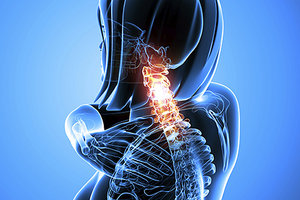In today's healthcare system, diagnoses and treatment plans follow a western medical model - especially if you work with attorneys or insurance companies. It is expected that you show objective clinical findings – often pulse or meridian diagnoses are considered subjective and not sufficient.
Classically, the examiner stands behind the patient and cups the patient's head in the hands and provides a gentle y-axis traction. I recall also being taught to cradle the head between the forearms to lift – but I find this awkward and the patient gets the impression that I am trying to do some kind of martial arts choke-hold. I don't like the forearm variation. I would also note that some texts indicate to lift the skull by the mandible – again, I don't like this. This can aggravate a TMJ condition or contribute to one. In my experience, it often creates other discomfort and compromises the exam.
In my exam flow, I will typically start with the Cervical Compression Test – gentle pressure down the y-axis from the vertex. Also note that adding in the rotational component to cervical compression – the Foraminal Compression Test – gives further insight into foraminal compromise. Immediately following compression, I will cup the mastoids in my palms (avoiding pressure on the TMJ) and traction up.
 Several options should now be considered:
Several options should now be considered:
- If traction produces pain – this indicates soft tissue injury and inflammation. There may very well be articular involvement, but there is over-riding muscle spasm.
- If traction decreases pain – this indicates compromise of the IVF or the disc. It may also help to localize pressure on the joint capsule. Please note that relief may be one sided – again, this helps you to localize your diagnosis. The recurrence of pain once you reduce traction is reduce is further confirmation of your findings.
- If traction doesn't do anything – stop for a moment and re-think your exam. In my experience a patient with acute cervical or upper dorsal symptoms will almost always respond with more or less pain to this maneuver.
Your exam should be as complete as possible. Orthopedic testing should provoke a response to localize a complaint. Make sure you are fully evaluating the area.
Evans' text also offers the clinical pearl that this test can be both diagnostic and indicative of proper therapy. Cervical distraction not only indicates the nature of the patient's complaint, but also provides a rationale for cervical traction as a part of a care plan. It should be further noted that when a patient requires more static force for relief, this will indicate a more severe nerve compression syndrome, and possibly indicate the need for surgical consult.
I would also note that some texts recommend holding traction for 30 to 60 seconds, but I have never had to wait this long. I typically find that the patient experiences a response to the maneuver very quickly.
As always, good documentation is key. Doing an exam and not fully recording the findings does not serve you or the patient. Check-off exam forms do not work here. Make sure you clearly define what the positive finding was when performing this maneuver. I like these tests because they are quick and simple - it should be easy to add these tests into your exam protocol. Certainly there are other tests, signs, and observations to be made in the individual case – the more information you have to confirm your findings, the more secure you are in your diagnosis and treatment protocol.
These extra notes will help you to document the severity the patients' complaints. This extra documentation can also help make the difference if you must justify your diagnosis to an insurer or third party. Take the extra few seconds to add these tests into your exam routine – they will serve you well.
Resources:
- Evans, R.C. (1994) Illustrated Essentials in Orthopedic Physical Assessment St. Louis, Missouri: Mosby.
- Hoppenfeld, S. (1976) Physical Examination of the Spine and Extremities San Mateo, CA: Appleton & Lange.
Click here for more information about Douglas R. Briggs, DC, Dipl. Ac. (IAMA), DAAPM, EMT.




